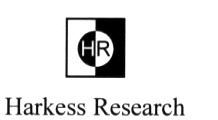
 Wisp
Unification Theory - 2 Symmetry
Wisp
Unification Theory - 2 Symmetry
- Home
- About Me
- Reasons why Einstein was wrong
- One-way speed of light experiments
- Hot topic
- Q&A
- ACES - The end of Relativity
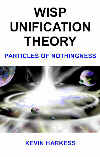
- Book Contents
- Introduction
- 1 Matter,Space and Time
- 2 Symmetry
- 3 Fractals
- 4 Wisp Space
- 5 Gravity
- 6 Electromagnetic Force
- 7 Wisp & S.R: Fundamentals
- 8 Wisp & S.R: Electrodynamics
- 9 Wisp & S.R: Doppler effect
- 10 Wisp & S.R: Relativistic Mechanics
- 11 Big bang
- Appendix A
- Appendix B
- Index A-Z
- Copyright
- Feedback
This page contains the complete chapter. To download the new 2011 2nd edition of wisp unification theory go to the homepage.
2
Symmetry
Wisp theory is essentially a geometrical theory, and an important property of its space is symmetry.
2.1 Symmetry
We tend to associate symmetry with shapes and patterns that stand out
from a plain background. Throw a stone into a pond and watch the ripples
spread out. They have a high degree of symmetry – circular symmetry.
However, the surface of the pond has an even higher degree of symmetry;
but because its surface has no interesting features we tend not to notice
its symmetry.
Mathematically speaking, symmetry is determined by a process of transformations
– rotations, reflections, translations, glide reflections, screw
(rotation with translation) – that leave the view of an object unchanged.
Without carrying out any transformations, an equilateral triangle (Figure
2.1) possesses an identity – its shape, its ‘trivial’ symmetry.
It has three lines of bisection and it can rotate through 60° or 120°
and appear unchanged. It can also be reflected about its lines of bisection,
giving it a total of six symmetries.
A sphere has a higher degree of symmetry – spherical symmetry –
than say a cube. It can rotate through any angle about a point at its
centre, and it look exactly the same; do the same to a cube and it will
project different views for different angles. We say that the sphere is
spherically symmetric about a point at its centre.
We can determine the degree of symmetry for a cube by rotating it about
any of its eight vertices. Including three rotations per vertex and reflections,
the cube has 48 symmetries (8 × 3 rotational symmetries, each of
which has reflection symmetry).
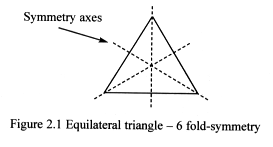
2.2 Face-centred cubic lattice
In 1611 Johannes Kepler conjectured that the face-centred cubic packing
is the most economic way of packing spheres in 3-D space – known
as the Kepler Conjecture.
It is easy to build a model to demonstrate this (Figure 2.2), but mathematical
proof is not so easy to demonstrate.
This method of packing has a high degree of symmetry and forms ‘empty
space’ in wisp theory – one-state wisp space. Because this stacking
forms parallel planes of wisps, the space is essentially ‘flat space’.
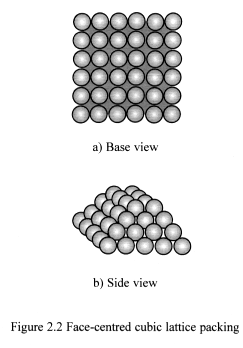
2.3 Spherical sphere packing
If we pack small spheres tightly around a larger central sphere, we obtain
a spherical shape similar to that shown in Figure 2.3 (the larger central
sphere is hidden from view). However, even though the shape stays roughly
spherical there are gaps between the spheres in its outer layers. The
reason gaps exist is because the outer layers are curved and the symmetry
associated with densely packed flat space gets lost.
Later, I will show that these gaps create spherical tension forces that
are responsible for the effects of gravity, where the small spheres represent
wisps and the larger central sphere is matter’s ‘zero-state
space’.
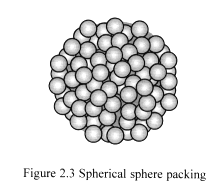
2.4 Symmetry-breaking
A long circular cylinder is placed upright in a uniformly slow-moving
stream, creating a bilateral symmetry flow pattern (Figure 2.4a). As flow
speed is increased, vortices that form at the rear of the cylinder begin
to break away, alternately shedding from the left and right – vortex
shedding.
Increasing flow speed causes the uniform flow associated with bilateral
symmetry to become unstable. The pattern breaks forming glide-reflection
symmetry flow. This is an example of symmetry-breaking (Figure2.4b).
The surface of a pond has a high degree of symmetry, and by throwing a
stone into it, its symmetry breaks, creating circular patterns –
ripples.
Many objects that we see around us result from symmetry-breaking processes.
They possess symmetries of their own and require separate rules to govern
their behaviour.
Later I will show that symmetry-breaking of flat space creates particles.
And even through particles have less symmetry than flat space; symmetry-breaking
creates objects of complex diversity that are bound by real surfaces.
Symmetry-breaking is responsible for the effects of electric charge. A
perfectly formed spherical particle has no electric charge. However, if
the inner central ‘zero-state space sphere’ is not perfectly
spherical, it will pass its asymmetry on to its outer layers. This causes
a clockwise or anticlockwise twist, which is responsible for the positive
and negative charge around a particle.
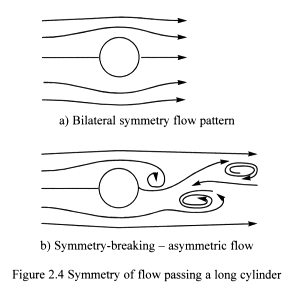
2.5 Antimatter
In 1928 Paul Dirac predicted the existence of antimatter.
Wisp theory considers antimatter to be the mirror image or reflection
of matter. Positive charges become negative and clockwise spins become
anticlockwise. However, the circular symmetry of a particle still remains
circular when reflected, and so gravitational force does not reverse.
It is likely that during the big bang, a state of asymmetry existed in
the early universe, causing more matter than antimatter to be created.
If the symmetry were perfect at that time, equal amounts of matter and
antimatter would have formed, resulting in complete annihilation of both.
2.6 Subatomic particles
In 1962 Murray Gell-Mann and Yuval Ne’eman used symmetry to organise
the particles into families. And in 1964 Murray Gell-Mann and George Zweig
independently proposed that the hundreds of discovered particles could
be explained by combinations of two or three fundamental particles called
quarks. (Quarks were named by Gell-Mann from the call of a bartender in
James Joyce’s Finnegan’s Wake: ‘three quarks for Muster
Mark’.)
Physicists discovered that particles could be grouped into patterns that
formed simple geometrical shapes. And new particles were successfully
predicted to fill gaps in these patterns.
After a 17 year search, in 1995 Fermi National Accelerator Laboratory
(Fermilab), near Chicago, Illinois, announced the discovery of the massive
‘top quark’. The last quark predicted from its symmetry pattern.
It seems highly probable that the underlying cause of this symmetry is
due to the fact that the fundamental particles are made from shapes that
possess a high degree of symmetry. Wisp theory supports the view that
the underlying cause of this symmetry is spherically shaped wisps that
form fractal patterns in wisp space.
Home --
About Me -- Reasons
why Einstein was wrong -- One-way
speed of light experiments -- Hot
topic --
Q&A -- ACES
- The end of Relativity --
Book Contents -- Introduction
-- 1 Matter,
Space and Time -- 2 Symmetry --
3 Fractals -- 4
Wisp Space -- 5 Gravity
-- 6 Electromagnetic Force
--
7 Wisp & S.R: Fundamentals
-- 8 Wisp & S.R: Electrodynamics
-- 9
Wisp & S.R: Doppler effect -- 10
Wisp & S.R: Relativistic Mechanics --
11 Big bang -- Appendix
A -- Appendix B --
Index A-Z -- Copyright
-- Feedback